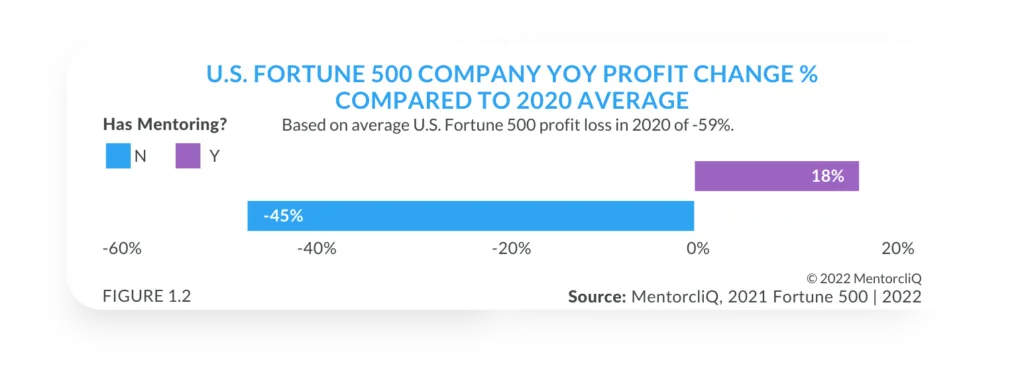Are more mentorship programs in your company’s future? Hopefully so, as retention rates are significantly higher for both mentees and mentors. Retention may be the top-level end goal for enterprise mentorship programs, but it’s not the only benefit. Mentoring programs also support other organizational needs, including:
- Improving the onboarding experience
- Bolstering functional skills training
- Supporting DEI initiatives
- Streamlining the leadership development process.
Whether you’re still learning more about mentoring or trying to help someone else get to the “big idea” behind the value of mentoring, the following information will help answer some of our most-asked questions about mentorship programs.
1. What Are Examples of Mentorship Programs?
Some of the most common examples of mentorship programs include:
- Onboarding
- Diversity and Inclusion
- Career Development
- Leadership Development
- Personal and Professional Development
- Functional Skills Development
- Networking
As you might expect, there are far more options that exist within these broader categories. LabCorp, for example, has won awards for its innovative Reverse Diverse mentoring program. That program could easily sit under practically every category we listed above, including DEI and Networking.

That, in itself, is the beauty of mentorship programs. They can be whatever you need them to be because they leverage the intelligence, experience, and capabilities of people to proactively influence learning and engagement.
Mentoring software is typically necessary to improve the quality of matches and support the growth and development of programs and participants. However, the participants are what make mentoring programs a truly effective employee development and engagement tool.
2. What Are the Best Mentorship Programs?
From a categorical perspective, there are no good or bad mentorship programs. All mentorship programs are good, or even possibly the best. It’s better to think about mentorship programs not in a superlative way (worst to best) but in a qualitative way.
Here’s what we mean by that.
Let’s say your organization has several tangible goals for the coming year. These vary across organizations, but you’ll find many companies’ goals are consistently the same, or similar, and may include:
- Reduce employee turnover
- Improve diversity metrics
- Build or grow company culture
- Upskill teams to increase sales for specific products
- Boost employee engagement to maintain or improve profit
There are always going to be a few questions related to company goals. Those questions usually boil down to:
- How do we measure success for this goal?
- How will this goal benefit the bottom line (revenue and profit)?
Yes, most goals circle back to profit in some way. But even more intangible goals, such as building or growing your company culture, still have an impact on profit. Organizations are inherently people-driven. When your people are supported the right way, all of your organization’s goals are easier to achieve, whether directly or indirectly.

Consequently, that’s why mentorship programs matter. By design, mentorship programs connect people together for authentic learning, engagement, and growth. Unsurprisingly, a people-driven strategy like mentoring is one of the most effective tools for supporting the foundation of almost any goal.
TL:DR: The best mentorship program is the one that most directly impacts your company’s goals. If you’re not sure which programs might be best, we can help. Contact us today so we can chat about your company’s goals. We can help you determine the best type of mentorship program for the goals you have in mind and help you with every step of the process, from ideation to launch to ROI measurement.
3. What Are the 3 Types of Mentoring?
There are actually more than three types of mentoring, but this is a commonly-asked question for a reason. Of all of the types of mentoring, you’ll find that most can fit under these three broad categories:
- Traditional Mentoring: These are typically 1-to-1 mentoring relationships, although they don’t always need to be designed with traditional structures (e.g., Reverse Mentoring would still fit as a type of “traditional” mentoring format because it’s still 1-to-1).
- Group Mentoring: A 1-to-many mentoring relationship where one mentor (or sometimes a few group leaders) oversees mentoring for a larger group of mentees.
- Distance (Virtual) Mentoring: Mentoring relationships that operate in a remote environment. Although listed here as a separate type, virtual mentoring can easily be operated as a traditional mentoring or group mentoring format.
The mentoring landscape can be a bit hard to pin down because of how many possible mentoring relationships could exist. And there are many types of mentors that may exist within these formats. Most of us have had a mentor at some point, although relatively few people have participated in formal and structured mentoring relationships. With 84% of Fortune 500 companies now offering mentoring programs, that’s changing rapidly.

Most of us will recognize different mentoring formats when we see them. The trick is to determine what type of format you need in different situations.
The high-level answer here is that there’s no limit to what type of mentorship program you might find at an organization, even if you do opt to lump them into broad categories. Regardless of which type you end up creating, always plan with the end in mind so that the type of programs you create meet the needs or problems you’re trying to solve.
4. Are Mentorship Programs Worth It?
The value of a mentorship program can be measured in many different ways. To determine if the program is “worth it,” you’ll need to first decide what problems your organization is trying to solve. We talked about that earlier, so we’ll highlight two specific areas.
Mentoring is worth it if you want to retain employees
Employee retention has always been a problem, long before the Great Resignation. As noted by Gallup, the cost to replace an employee can be as much as 2 times that employee’s salary or more for high-salaried employees in highly technical fields.
Mentoring has helped organizations save millions of dollars each year by retaining employees through turnover reduction. MentorcliQ’s own data from hundreds of customers, including many Fortune 500 companies, backs that up. Companies that use mentoring programs reduce turnover by an average of 50% for mentoring program participants.
Let’s do some back-of-napkin math.
Let’s say your company has a 27% turnover rate for a certain class of employees. (This may seem high, but that’s exactly what the medical field is dealing with right now for Registered Nurses.) Maybe these employees are compensated at $50,000 per year. If 27% quit, you’re down to 73 employees instead of the 100 you need to make sure your operation doesn’t come grinding to a halt.

Your company now needs to replace those staff. According to Gallup’s research, replacing those 27 workers will cost you as much as 2X each worker’s salary, or in this case, $2.3 million in replacement costs.
Had you retained even half of those employees, your replacement costs would have dropped to $1.15 million.
Most companies have an expected amount of turnover, meaning turnover costs are usually already factored into the company’s spending projections. Since creating a mentorship program can reduce turnover by 50% (sometimes more), companies can expect to save a tremendous amount of money on an expense they’ve likely already included in their budgets.
Mentoring is worth it if you want to increase employee engagement
This ties not-so-subtly into retention, but it’s important to note separately. There’s a large body of research that shows companies that have better employee engagement also have better employee retention stats. A Gallup analysis found that business units with high levels of engagement enjoyed 59% less turnover than those with low engagement.
The study also indicates that as far as increasing engagement, “the primary emphasis should be on elements that engage workers and drive results, such as clarity of expectations, the opportunity to do what they do best, development and opinions counting.”

As it were, this is why mentoring typically increases engagement (and retention) for both mentors and mentees. In some cases, we’ve recorded clients who have found better retention rates among their mentor population than their mentee population — slightly, but enough to note the significance of mentoring on employee engagement and overall well-being in the workplace for all mentorship program participants.
5. How Do I Start a Mentorship Program?
There’s a right way and a wrong way to start a mentoring program. The wrong way to start a mentorship program often looks like this:
- Not planning with the end in mind
- Not gathering data to understand what company needs exist
- Going it alone without getting executive buy-in first
- Attempting to launch a manually-run pilot program first
- Trying to match participants manually in excel or by hand
- Not socializing the program before launching across the organization to build interest
- Not providing mentors and mentees with training material
- Leaving all aspects of the program completely unstructured
That’s only the tip of the iceberg, but hopefully, you get the point. The right way to start a mentorship program is essentially the exact opposite:
- Researching what your goals or objectives exist at your company
- Aligning your mentoring strategy to those goals
- Determining which types of programs can help meet those goals
- Getting an executive sponsor and building a team of leaders
- Preparing and delivering a persuasive pitch on why mentoring programs are necessary to your executive leaders
- Creating the structure of your program prior to launch
- Socializing mentoring programs through various means to build interest and excitement before you launch
- Training mentors (and mentees) on how to be effective in their respective roles
- Using mentoring software to automate matching and remove bias from the matching process, as well as help you gather the critical program data needed to determine ROI
That process may be new to you. It may even seem overwhelming. You also don’t have to do any of it alone. MentorcliQ provides you with the tools and experience to simplify every aspect of planning, launching, growing, and proving the value of your mentoring programs.
Contact us today to take the next steps in starting or expanding your mentoring programs.




